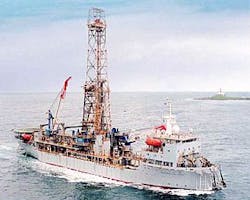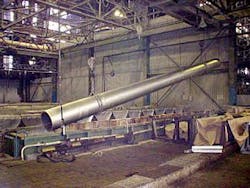Operating at water depth of 3,040 ft offshore Brazil, the Noble Leo Segerius was the first drillship to deploy the new aluminum-alloy drilling risers. These risers are rated for use at water depths in excess of 5,000 ft (Fig. 1)
Drilling off Brazil has confirmed that a newly developed aluminum-alloy riser allows existing drilling rigs to drill in greater water depths without incurring extensive rig modification costs.
Noble Corp. successfully deployed the first string of aluminum-alloy riser in January 2003 from the Noble Leo Segerius drilling vessel (Fig. 1), operating in 3,040 ft of water off Brazil. Since then, five additional wells drilled off Brazil have used the riser.
The new riser is the first industry-approved drilling riser to be manufactured from an aluminum alloy.
Conventional steel drilling risers, generally may be inappropriate for deeper water developments. As drilling activities extend further offshore, the structural support of the rig deck must be enhanced to support the additional weight of a greater number of conventional steel riser joints and the increased capacity of the tensioner system required to stabilize the riser during drilling operations.
Both upgrades can be cost-prohibitive and time consuming, and they limit the availability of drilling vessels to current and prospective clients.
Looking to extend the capabilities of existing drilling vessels for drilling operations in deeper water with minimal upgrades or alterations, Noble Corp. became convinced that a more efficient and economical solution was to reduce the riser weight by replacing the conventional line-pipe grades of high-strength steel with a lighter-weight material.
It found a qualified producer of extruded aluminum alloys in tubular form and technically experienced manufacturing facilities in Russia.
Benefits
Noble's newly developed aluminum-alloy drilling riser was among the technologies introduced at the recent 2003 Offshore Technology Conference in Houston.
A 75-ft long aluminum-alloy riser joint weighs about 17,000 lb and is about 30% lighter in air than a conventional steel riser joint that weighs about 24,000 lb.
The design also removes additional weight by the adoption of aluminum-alloy for producing the choke, kill, hydraulic, and booster lines. Because more aluminum-alloy riser joints can be stored on deck (Fig. 2) without exceeding weight and handling limitations, an existing drilling vessel's maximum water depth increases significantly.
The lighter-weight aluminum-alloy riser also reduces the number of buoyancy modules required for deepwater drilling by as much as 35%. Buoyancy modules for 2,000-5,000 ft water depths may cost $25,000-40,000/riser joint and modules used in deeper water command significantly higher costs.
Examination of the first string of aluminum-alloy riser deployed from the Noble Leo Segerius confirmed the material's suitability and performance under those deepwater conditions.
This riser allows existing drilling rigs to work in deeper water. For example, a rig capable of drilling in 4,000 ft of water now can work in 6,500 ft of water without requiring capital upgrades. Noble is also developing an ultra-deepwater riser, capable of extending a drilling vessel's water depth rating from 7,000 to 10,000 ft.
While the design of drilling equipment is an unusual scope of work for Noble, it justified this venture as an opportunity to improve the drilling capabilities of its assets and thus better serve its clients.
Petroleo Brasileiro SA (Petrobras), which showed an early interest in the aluminum-alloy riser technology and encouraged Noble's development of the program, contracted the use of the Noble Leo Segerius equipped with the new aluminum-alloy riser system for drilling wells offshore Brazil. Noble's constant communication with Petrobras during the development of the system resulted in the system's first operational deployment on a Petrobras location.
null
Petrobras has commented on the benefits of efficient transition from drilling to completion operations due to the absence of corrosion. When steel riser lines are used, corrosion must be removed from the lines prior to well completion operations. The new aluminum-alloy riser system eliminates this step, saving time and reducing overall well costs.
Manufacturing
The concept for a new lightweight drilling riser originated from Noble's work in conjunction with a Russian company. Russian advisors experienced in developing aluminum alloys for applications in the aerospace industry played an integral role in the project's design and manufacturing scope.
Following prototype testing in February 2000 and subsequent modifications, production of the first drilling riser joint began in January 2002. Noble shipped the first 100-joint string to Brazil in July 2002.
An aluminum alloy's advantageous strength-to-weight ratio was a significant reason Noble investigated the nonferrous material for use in riser construction. To justify the selection of an aluminum alloy in the development of a new lightweight drilling riser system, the company implemented the following full-scale testing regimes:
Tensile strength testing of the welded joint.
Fatigue strength testing of the welded joint.
Finite element analysis of the stress-strained state of riser flange-type coupling.
Finite element analysis of the stress-strained state of bolted riser-to-flange coupling connection.
Full-scale testing of bolted flange connection and flange-to-pipe welded joint under tension (direct pull) and fatigue loading.
Full-scale testing of riser joint tension (direct pull).
Proof pressure testing of service lines.
Noble's decision to manufacture the riser joints in Russia was driven by economics and the availability of extrusion and forging equipment of the required capacity. Far more alloys of aluminum have been developed in Russia than elsewhere. Also readily available in Russia is low-cost energy for reducing the raw bauxite and alloying it into ingots for processing into the various forms of wrought aluminum.
The selected Russian manufacturer also possesses one of the largest extrusion presses in the world, a 35,000-tonne horizontal press capable of producing large-diameter pipe sections (Fig. 3) in sizes greater than the range currently available in the US or Canada.
Riser design
API Specification 16Q and related guidelines for drilling riser design, as well as applicable ASME Boiler and Pressure Vessel (B&PV) codes, generally focus on using low-alloy steel. The design and production of Noble's aluminum-alloy riser, therefore, required detailed qualification and analyses to establish "fit for purpose" specifications.
Current design criteria are summarized as follows:
- Tension capacity—1.5 million lb (680 tonnes).
- Riser construction—75-ft overall length with one center weld and flanges welded at each end.
- Riser body ID—19.69 in. (500 mm).
- Riser body wall thickness—1.18 in. (30 mm).
- Design temperature maximum—248º F. (120º C.).
- Design temperature minimum—–4º F. (–20 º C.).
- Forged flanges OD—40.94 in. (1,040 mm).
- Design pressure choke and kill lines—15,000 psi with 4.50 in. (114.3 mm) bore.
- Design pressure booster line—5,000 psi with 4.00 in. (101.6 mm) bore.
- Design pressure hydraulic line—5,000 psi with 2.00 in. (50.8 mm) bore.
For initial design and test purposes, Noble developed the deepwater aluminum-alloy riser system to accommodate a rated 1.5 million lb top tension. It expected the anticipated water depth for this design criterion to be 4,000-6,500 ft.
The developers, however, recognized the demand for drilling capabilities at much greater water depths. They were mindful to create a design that could be developed further to accommodate greater water depths, in respect to hydrostatic pressures and more extreme environmental conditions.
The water depth at which a drilling vessel can operate depends on the top-tension capacity and related environmental, vessel motion, and operating parameters, plus the space available for storage and handling of riser joints.
While it is conceivable to drill in 10,000 ft and deeper water depths with a low-alloy steel riser, it is not considered economically feasible because of the required capital upgrades to accommodate the additional loads on the current generation of drilling vessels.
The design of an aluminum-alloy drilling riser is almost identical to that of a steel riser. The aluminum-alloy riser system consists of 75-ft riser joints, with flanged-type couplings that are connected by high-strength steel bolts, and service lines (choke and kill, booster, and hydraulic) that are connected by conventional pin and box-type couplings (Fig. 4).
To prevent the corrosion damage, it was necessary to isolate galvanically incompatible metals. The riser design achieves this through the use of nonmetallic seals between flange-type coupling connections and the use of a polymer-based coating system for isolating the high-strength steel bolts.
Integration of the aluminum-alloy drilling riser joints into an all-steel drilling vessel and associated systems operating on the seabed and in the confines of the drilling rig creates the opportunity for the aluminum to act as an anode and therefore corrode preferentially with respect to the cathodic steel systems.
To alleviate this problem, the designers implemented a cathodic protection system in the form of bonded sacrificial anodes. This system allows the sacrificial anodes to deplete in preference to the aluminum alloy.
Experienced personnel and qualified welding techniques were used to join the flange-to-tube and tube-to-tube joints that make up the 75-ft long aluminum-alloy drilling riser joint. The work was carried out and qualified in accordance with recognized international standards.
Post-weld heat treatment on the welded areas has further optimized the tensile and fracture toughness properties and relieved residual stresses.
The joints include a suitable consumable alloy containing limited amounts of anodic elements such as zinc and magnesium. This alloy maintains a balanced galvanic potential across the welded joints that minimizes the potential for galvanic (bimetallic) corrosion caused by the variation in galvanic potential of the weld metal, heat-affected zones, and parent materials.
ABS classification
The riser system required extensive testing and evaluation to qualify its manufacturing and performance specifications for deepwater applications because no industry standards exist for the manufacture or use of an aluminum-alloy drilling riser system.
null
In May 2003, the American Bureau of Shipping (ABS) issued a classification certificate to Noble, approving the manufacture and use of the aluminum-alloy riser system for deepwater drilling.
The ABS classification certification of the aluminum-alloy riser system is evidence that the system has been designed, constructed, and maintained in accordance with ABS CDS GUIDE, 1990, the ASME BPV code, and API Guides as Applicable.
New applications
Several operating companies, eying the successful manufacture and implementation of the aluminum-alloy drilling riser, have expressed an interest in aluminum-alloy production risers as a potential alternative to steel risers.
Deepwater applications are of special interest because weight and physical properties of materials are important considerations for these operations. As a result, Noble currently is investigating the opportunity to expand the use of aluminum alloys in production risers. F
The authors
Thomas E. Prosser is a consultant to the Noble Technology Services division of Noble Corp., Sugar Land, Tex. He has over 35 years of domestic and international experience in various operations, engineering, manufacturing, and marketing functions. Currently he is engaged in the design and manufacture of Noble's aluminum-alloy riser in Russia, and is investigating other applications for these alloys for Noble. Prosser is an industrial engineering graduate of the Georgia Institute of Technology.
Hans Deul is director of subsea and drilling systems for Noble Drilling Services Inc., Sugar Land, Tex. He has more than 30 years experience in the offshore drilling industry. Deul has a bachelor's degree in mechanical engineering from a technical college in The Hague, the Netherlands.
Bill Rhone is area manager in Russia for Noble International Ltd., Moscow. He has more than 28 years of experience in the oil industry and has held various positions with an oil field equipment manufacturer and drilling services companies. He has supported Noble's materials management services in various positions including director of materials management. Rhone holds a BA in business administration and economics from Midwestern State University, Wichita Falls, Tex.








